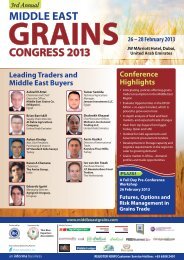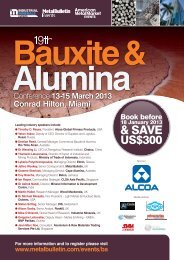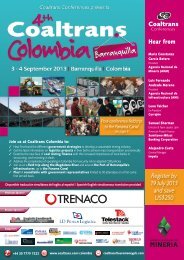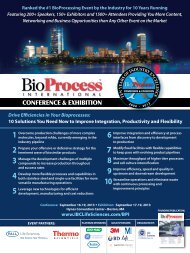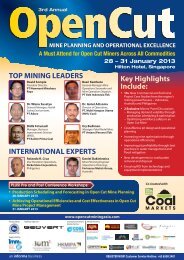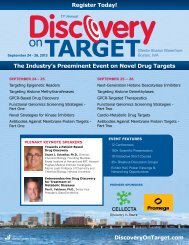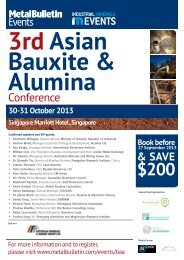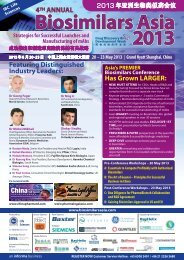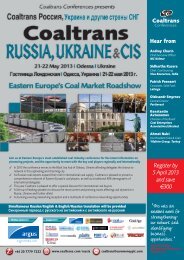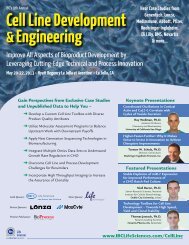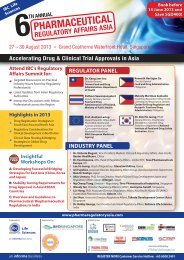Product and Process Variants & Impurities
Product and Process Variants & Impurities
Product and Process Variants & Impurities
Create successful ePaper yourself
Turn your PDF publications into a flip-book with our unique Google optimized e-Paper software.
The Industry’s Leading Case Study-Driven Conferences to Help You<br />
Characterize Biological <strong>Product</strong>s <strong>and</strong> Identify/Control <strong>Variants</strong> & <strong>Impurities</strong><br />
October 21-23, 2013 • L’Enfant Plaza Hotel • Washington DC<br />
Access Any Session at These Co-located Events for One Price<br />
IBC’s 17th Annual<br />
Well Characterized Biologicals<br />
Case Studies, CMC Strategies <strong>and</strong> Regulatory Perspectives on Protein Characterization <strong>and</strong><br />
<strong>Product</strong> Comparability for Biotechnology <strong>Product</strong>s <strong>and</strong> Biosimilars throughout the <strong>Product</strong> Lifecycle<br />
Featured Presentation to Help You Avoid Common Pitfalls in Your CMC Submissions:<br />
Top 10 List of Analytical Inadequacies in IND or BLA Submissions<br />
Alfred Del Grosso, Team Leader, Analytical Chemistry, Division of Biological St<strong>and</strong>ards <strong>and</strong> Quality Control, CBER, US FDA<br />
Find Strategies for Successful<br />
<strong>Product</strong> Characterization of:<br />
• ADCs, Bispecifics, Fusion Proteins<br />
• Vaccines, Combination <strong>Product</strong>s<br />
• Biosimilars, Monoclonal Antibodies<br />
Interact with Regulators<br />
Who Will Share Expectations for:<br />
• Higher Order Structure, Vaccine Assays<br />
• Biosimilars, Comparability<br />
• Host Cell Proteins, Particulates, <strong>Impurities</strong><br />
IBC’s Inaugural<br />
www.IBCLifeSciences.com/WCB<br />
<strong>Product</strong> <strong>and</strong> <strong>Process</strong> <strong>Variants</strong> & <strong>Impurities</strong><br />
Identification <strong>and</strong> Effective Control of <strong>Variants</strong> <strong>and</strong> <strong>Impurities</strong> for Optimal <strong>Process</strong>ing <strong>and</strong> <strong>Product</strong> Quality<br />
Featured Presentations provide Regulatory <strong>and</strong> Industry Perspectives on Controlling<br />
<strong>Variants</strong> <strong>and</strong> <strong>Impurities</strong>, Monitoring Quality <strong>and</strong> Addressing Future Challenges<br />
Mikhail V. Ovanesov, Ph.D., CBER, US FDA • C. Mark Smales, Ph.D., University of Kent • Erwin Freund, Ph.D., Amgen Inc.<br />
Optimize <strong>Process</strong> <strong>and</strong> <strong>Product</strong> Quality by Building<br />
In Variant <strong>and</strong> Impurity Control Protocols through:<br />
• Supply Chain Management, Manufacturing<br />
Enhancements, Assays<br />
• Physicochemical <strong>and</strong> Characterization Data<br />
www.IBCLifeSciences.com/<strong>Variants</strong><br />
Achieve Greater Acceptance Criteria <strong>and</strong> Mitigate<br />
Variant <strong>and</strong> Impurity Risks by Applying:<br />
• Stable Isotope-Tagged Reference St<strong>and</strong>ards<br />
• Multi-Dimensional Characterization, LC/MS <strong>and</strong><br />
Biophysical Methods<br />
Silver Sponsor:<br />
Featured Publication:<br />
Organized by:
Find Practical Strategies <strong>and</strong> New Techniques to Help You<br />
IBC’s 17th Annual<br />
Well Characterized Biologicals<br />
More Case Studies <strong>and</strong> Unpublished Data You Can Apply in Your CMC Programs<br />
Register today to hear practical advice in these critical areas that you can apply in your own lab:<br />
• Characterize ADCs, Bispecifics <strong>and</strong> Fusions to Help You<br />
Overcome the Challenges of More Complex Molecules<br />
• Implement Improved CMC Strategies for Biosimilars <strong>and</strong><br />
Vaccines So You Can Meet Regulatory Expectations<br />
in Your IND/BLA Submissions<br />
• Improve <strong>Product</strong> <strong>and</strong> <strong>Process</strong> Comparability to Prepare<br />
for Both Scale-up Efforts <strong>and</strong> Manufacturing Site Changes<br />
Featured FDA Presentation<br />
Top 10 List of Analytical Inadequacies<br />
in IND or BLA Submissions<br />
Alfred Del Grosso, CBER, US FDA<br />
Tuesday, October 22 • 10:15 am<br />
• Develop Functional Biological Assays <strong>and</strong> Evaluate Novel<br />
Analytical Technologies to Support Characterization of<br />
Monoclonal Antibodies <strong>and</strong> Other Diverse <strong>Product</strong>s<br />
• Analyze Host Cell Proteins, <strong>Impurities</strong> <strong>and</strong> Degradation<br />
Pathways to Help You Control <strong>Product</strong> <strong>and</strong> <strong>Process</strong> Quality<br />
• Explore the Biophysical <strong>and</strong> Structural Properties of Your<br />
Molecules to Provide Better Information for Your Regulatory Dossier<br />
Avoid Common Pitfalls in Your Analytical <strong>and</strong> CMC Studies<br />
Case Studies <strong>and</strong> Lessons Learned from:<br />
Amgen, Genentech, ImmunoGen, Oncomed, AbbVie, S<strong>and</strong>oz,<br />
Biogen Idec, Millenium/Takeda, Merck, MedImmune, Novavax,<br />
Sanofi Pasteur <strong>and</strong> more!<br />
One Registration Fee Gives You Access to Two<br />
Call for Poster Presentations <strong>and</strong> Best Poster Award<br />
Consider presenting a poster at this conference to derive more value from attending. Share your research<br />
with your peers <strong>and</strong> learn from other posters as well. Many attendees tell us that being selected for<br />
a poster presentation helps to facilitate their company approval process to attend the conference. All<br />
posters will be reviewed by the conference advisory board <strong>and</strong> a Best Poster Award will be presented<br />
during the conference. Submit your poster abstract online today at www.IBCLifeSciences.com/WCB or<br />
www.IBCLifeSciences.com/<strong>Variants</strong>. Poster abstract submission deadline: September 20, 2013.<br />
Oral Poster Presentation Session<br />
Several poster presenters will be chosen to provide a short oral presentation of their poster during the<br />
conference sessions. Submit your poster abstract today for a chance to be selected for this opportunity.<br />
Make New Contacts <strong>and</strong> Enjoy Dinner with Fellow Attendees<br />
A dinner sign-up sheet will be provided during the conference to allow you to connect with other<br />
attendees who are interested in meeting others for dinner after the conference sessions.<br />
Regulatory Advice You Can Apply<br />
With 8 confirmed speakers from FDA <strong>and</strong> Health Canada, along with other regulatory/policy experts<br />
from the US Pharmacopeia <strong>and</strong> industry, you’ll walk away from this conference<br />
with an update on changing regulatory guidances <strong>and</strong> clearer regulatory expectations<br />
for your molecules. Many more FDA speakers have been invited to present.<br />
Please visit the conference websites for updates as they confirm.<br />
“Great conference! I learned a lot <strong>and</strong> got some great ideas for the development of in-house methods. I thought the<br />
FDA presentations were terrific…<strong>and</strong> put the fear of God in me” – Jacqueline McGourty, Associate Director, Emergent Biosolutions<br />
2 Register Early for Best Savings • Up-to-date Program Information • www.IBCLifeSciences.com/WCB
Meet Regulatory Expectations for a Wide Range of Molecules<br />
IBC’s Inaugural<br />
<strong>Product</strong> <strong>and</strong> <strong>Process</strong> <strong>Variants</strong> & <strong>Impurities</strong><br />
The Only Industry Forum Covering Variant <strong>and</strong> Impurity Control <strong>and</strong> Mitigation Strategies<br />
• Navigate the Characterization L<strong>and</strong>scape for Increased <strong>Product</strong><br />
Underst<strong>and</strong>ing <strong>and</strong> Speed with Pfizer’s Technology Roadmap<br />
• Hear the Level of Agreement on Sizing <strong>and</strong> Counting<br />
from 24 Laboratories in the NIST’s Subvisible Particle Round-<br />
Robin Comparison<br />
• Apply Regeneron Pharmaceutical’s Strategy to Characterize<br />
Subvisible Particles Impact on Virus Filters for Robust <strong>Process</strong><br />
<strong>and</strong> <strong>Product</strong>ion<br />
• Learn How AbbVie Uses Stable Isotope-Tagged Reference<br />
St<strong>and</strong>ards <strong>and</strong> Analytical Tools for Detecting <strong>Variants</strong> <strong>and</strong> PTMs<br />
at Low Levels <strong>and</strong> Maintaining Manufacturing Consistency<br />
• Discover How Genentech is Using Nucleic Acid Technologies<br />
as Complementary Tools for Early Mutation Detection<br />
• Set Proactive Steps for Manufacturing, QbD Expectations<br />
<strong>and</strong> other <strong>Process</strong> Specifications with Amgen’s Aggregation<br />
Control Strategy<br />
Featured FDA Presentation<br />
Changing the Manufacturing <strong>Process</strong> to<br />
Remove <strong>Impurities</strong> <strong>and</strong> Monitoring <strong>Product</strong><br />
Quality Using Relevant Lot Release Assays<br />
Mikhail V. Ovanesov, Ph.D., CBER, US FDA<br />
Tuesday, October 22 • 8:15 am<br />
Conferences <strong>and</strong> Shared Exhibits, Posters & Networking<br />
View New Technology in the Exhibit Hall<br />
Enhance Your <strong>Process</strong> Development Efforts to Mitigate<br />
<strong>Product</strong>- <strong>and</strong> <strong>Process</strong>-Related Variant <strong>and</strong> <strong>Impurities</strong><br />
Case Studies <strong>and</strong> Leadership Insights from: AbbVie,<br />
ABC Laboratories, Amgen, Bristol-Meyers-Squibb, Boehringer<br />
Ingelheim, Genentech, Genzyme, Merck, NIST, NIBRT, Pfizer,<br />
Protein Sciences Corp., Regeneron Pharmaceuticals, SAFC<br />
Carlsbad, SAIC-Frederick, University of Kent <strong>and</strong> Waters<br />
Find new analytical technologies, products <strong>and</strong> services to help you with your product characterization efforts<br />
in the exhibit hall. Both conferences share all exhibit <strong>and</strong> networking breaks so you will have an opportunity to<br />
meet with vendors <strong>and</strong> technology providers from both events all under one roof.<br />
Participate in “Hot Topic” Roundtable Discussions<br />
Moderated by FDA<br />
<strong>and</strong> Industry Speakers<br />
Discuss <strong>and</strong> debate important industry issues with other attendees <strong>and</strong> speakers during these informal, “Hot<br />
Topic” roundtable discussions moderated by conference speakers. To suggest a topic you would like to<br />
discuss, please email Michael Keenan at mkeenan@ibcusa.com or Mark DeSorbo at mdesorbo@ibcusa.com.<br />
Who Should Attend<br />
These co-located conferences offer too much content for just one person. Send a team from your company to capitalize on this unique<br />
opportunity to meet face to face with multiple regulators <strong>and</strong> to benefit from hearing unpublished data that will only be shared in person at<br />
these conferences.<br />
The practical advice <strong>and</strong> industry case studies at this event will benefit Scientists, Technicians,<br />
Managers, Lab Heads, Directors <strong>and</strong> other specialists in the following departments:<br />
• Analytical R&D<br />
• CMC<br />
• Protein Analytical Chemistry<br />
• Bioassay Development<br />
• Regulatory Affairs <strong>and</strong> QA/QC<br />
• <strong>Process</strong> Development<br />
• <strong>Product</strong> Development<br />
• Technical Operations/Manufacturing Sciences<br />
• Drug <strong>Product</strong> Manufacturing<br />
• Clinical Supply Chain Procurement<br />
Send a Group of 3<br />
<strong>and</strong> the 4th goes FREE!<br />
For more information on<br />
group pricing or to register<br />
a group, call our group sales<br />
advocate at 646-895-7445<br />
“I enjoyed the conference. There was plenty of new knowledge gained from the presentations <strong>and</strong> new opportunities<br />
for networking with colleagues in the industry” – Bridgitte Speights, Director, CMC Regulatory Affairs, Teva<br />
Register Early for Best Savings • Up-to-date Program Information • www.IBCLifeSciences.com/<strong>Variants</strong> 3
Well Characterized Biologicals<br />
8:30 Chairman’s Remarks<br />
Michael G. Mulkerrin, Ph.D., Vice President, <strong>Process</strong> Development, OncoMed<br />
Pharmaceuticals<br />
Characterization of Novel Antibody Constructs <strong>and</strong><br />
Monoclonal Antibodies<br />
8:45 UNPUBLISHED DATA Physicochemical Characterization of<br />
Maytansinoid ADCs<br />
Manufacturing of maytansinoid ADCs using ImmunoGen’s technology relies<br />
on the attachment of the cytotoxic agent molecules (DM1 or DM4) via a<br />
linker to amino groups on antibodies. This attachment changes some of<br />
the properties of the antibody molecules. This presentation will describe<br />
development <strong>and</strong> implementation of an appropriate panel of analytical<br />
techniques for release <strong>and</strong> characterization of maytansinoid ADCs.<br />
Alex Lazar, Ph.D., Head of Analytical <strong>and</strong> Pharmaceutical Sciences,<br />
ImmunoGen, Inc.<br />
9:15 UNPUBLISHED DATA Strategy for the Characterization of<br />
Bispecific Antibodies<br />
Bispecific Antibodies are a class of therapeutics gaining in prevalence.<br />
Advances in protein engineering are generating a number of solutions for<br />
the generation of bispecific antibodies. There are common challenges in the<br />
manufacture of these molecules, which include quantitating the amount of<br />
the homodimer <strong>and</strong> heterodimer <strong>and</strong> characterizing the nature of unwanted<br />
variants. This presentation will discuss the strategy <strong>and</strong> analytical approaches<br />
to characterize bispecific antibodies.<br />
Michael G. Mulkerrin, Ph.D., Vice President, <strong>Process</strong> Development,<br />
OncoMed Pharmaceuticals<br />
9:45 CASE STUDY Analytical Characterization Strategies for<br />
Bispecific Molecules <strong>and</strong> Novel Antibody Constructs<br />
Bispecific antibody-like molecules <strong>and</strong> other formats investigated present new<br />
therapeutic opportunities. However, analytical challenges are encountered<br />
when adopting platform monoclonal antibody formats to evaluate these<br />
complex molecules. In this presentation we will highlight a few case studies to<br />
illustrate our approach to studying antigen binding <strong>and</strong> other pharmaceutical<br />
properties of these molecules.<br />
Leslie T. Aless<strong>and</strong>ri, Senior Scientist II, Protein Analytics,<br />
AbbVie Bioresearch Center<br />
10:15 Networking Refreshment Break <strong>and</strong> Exhibit/Poster Viewing<br />
10:45 Development of a Flow-through Dialysis System –<br />
A Novel Approach in Evaluating Biological Relevance of<br />
Recombinant Proteins<br />
For recombinant proteins, underst<strong>and</strong>ing of in vivo behavior of product variants<br />
is important <strong>and</strong> desirable but often is very challenging to achieve. In this<br />
presentation, we describe the development of an in vitro flow-through dialysis<br />
system to mimic in vivo behavior of disulfide isoforms in monoclonal antibodies<br />
<strong>and</strong> Fc-fusion proteins. The system is capable of maintaining a low level redox<br />
concentrations found in human blood. Using this system, we studied the<br />
conversion kinetics of disulfide variants in vitro under physiological conditions.<br />
Gang Huang, Ph.D., Scientific Director, <strong>Process</strong> <strong>and</strong> <strong>Product</strong> Development,<br />
Amgen, Inc.<br />
11:15 CASE STUDY/UNPUBLISHED DATA Characterization of an Fc Fusion<br />
Protein Therapeutic C<strong>and</strong>idate: Lessons Learned, Experiences<br />
<strong>and</strong> Future Challenges<br />
An Fc fusion protein therapeutic comprised of a receptor extracellular domain<br />
(ECD) fused with the Fc portion of an IgG1 antibody was analyzed by multiple<br />
methods to confirm the predicted structure <strong>and</strong> establish the product profile.<br />
The ECD, containing two additional N-linked glycosylation sites as well as a<br />
disproportionately high number of acidic amino acids, afforded some unique<br />
analytical challenges. The particular challenges confronted by Fc-fusion product<br />
c<strong>and</strong>idate characterization will be discussed.<br />
James Bourell, Senior Scientist, <strong>Process</strong> Development, OncoMed Pharmaceuticals<br />
Reference St<strong>and</strong>ards for Biologicals<br />
11:45 Regulatory Perspectives on the Use of Reference St<strong>and</strong>ards<br />
for Licensed Therapeutic Proteins<br />
Ashutosh Rao, Ph.D., <strong>Product</strong> Quality Reviewer, Division of Therapeutic<br />
Proteins, CDER, US FDA<br />
Monday, October 21, 2013<br />
7:00 Registration <strong>and</strong> Coffee<br />
<strong>Product</strong> <strong>and</strong> <strong>Process</strong> <strong>Variants</strong> & <strong>Impurities</strong><br />
8:00 Chairman’s Opening Remarks<br />
David Ouellette, Senior Scientist II, Protein Analytics, <strong>Process</strong> Sciences,<br />
AbbVie Bioresearch Center<br />
Featured Presentation<br />
8:15 The Challenges of <strong>Product</strong>- <strong>and</strong><br />
<strong>Process</strong>-Related <strong>Impurities</strong> to an Evolving<br />
Biopharmaceutical Industry<br />
C. Mark Smales, Centre for Molecular <strong>Process</strong>ing & School<br />
of Biosciences, University of Kent, United Kingdom<br />
Analytical Methods <strong>and</strong> Technologies for Identifying <strong>and</strong><br />
Controlling <strong>Product</strong>-Related <strong>Variants</strong> <strong>and</strong> <strong>Impurities</strong><br />
8:45 Optimizing Host Cell Protein Assay to Enable Rapid<br />
<strong>Process</strong> Development<br />
Abstract not available at time of print. Please visit<br />
www.IBCLifeSciences.com/<strong>Variants</strong> for updates.<br />
Brett Carter, Associate Scientist, MedImmune<br />
9:15 Stable Isotope-Tagged Reference St<strong>and</strong>ards for Detection<br />
of Sequence <strong>Variants</strong> <strong>and</strong> PTMs<br />
The current analytical methods that are used to identify the presence of<br />
mutations or modifications in an antibody sample may not always be able to<br />
detect these changes when they are present at a low level. A quantitative mass<br />
spectrometry-based approach, the SITRS method, was developed <strong>and</strong> further<br />
optimized to identify these minute differences down to 1%. Fully-automated<br />
data analysis enables high resolution comparability of therapeutic proteins<br />
at the peptide level without a prior knowledge of the presence or nature of<br />
the variant. The utility of the SITRS method in discovering <strong>and</strong> quantitating<br />
sequence variants <strong>and</strong> PTMs will be demonstrated by specific case studies.<br />
Anton V. Manuilov, Ph.D., Senior Scientist II, Protein Analytics,<br />
AbbVie Bioresearch Center<br />
9:45 Use of St<strong>and</strong>ard Analytical Tools for Screening <strong>Product</strong><br />
<strong>Variants</strong> During C<strong>and</strong>idate Selection of Antibodies<br />
Manufacturing well-characterized biologics has become an expectation for<br />
antibody <strong>and</strong> bispecifics production within the biotech industry. Analytical<br />
methods that examine physicochemical properties of molecules when screening<br />
multiple c<strong>and</strong>idates are helpful in identifying sequence liabilities. This information<br />
is important for identifying c<strong>and</strong>idates with appropriate shelf life, desired quality<br />
attributes <strong>and</strong> ensuring manufacturing consistency during clinical development.<br />
David Ouellette, Senior Scientist II, Protein Analytics, <strong>Process</strong> Sciences,<br />
AbbVie Bioresearch Center<br />
10:15 Networking Refreshment Break <strong>and</strong> Exhibit/Poster Viewing<br />
10:45 CASE STUDY/UNPUBLISHED DATA Mutation Detection <strong>and</strong> Discovery<br />
by the Nucleic Acid Technologies<br />
Sequence variants as a product quality attribute needs to be analyzed for<br />
pharmaceuticals generated by recombinant technology. Mutations at the DNA<br />
level can lead to protein sequence variants <strong>and</strong> may not change the amino acid<br />
coding. Nucleic acid technologies allow earlier detection of mutations, <strong>and</strong><br />
serve as complementary tools to sequence variant analysis at the protein level.<br />
Judith Shimoni, Ph.D., Senior Scientist / Group Leader, Protein Analytical<br />
Chemistry, Genentech<br />
11:15 CASE STUDY/UNPUBLISHED DATA Assess <strong>Product</strong>-Related <strong>Variants</strong> by<br />
Targeted Multi-Dimensional Characterization Methods<br />
Monoclonal antibodies (mAbs) are well characterized proteins <strong>and</strong> established<br />
as the most promising drug classes in the biopharmaceutical industry. This talk<br />
discusses a balanced strategy to assess product-related variants of mAbs in early<br />
stage as part of the QbD approach. Case studies will be used to elucidate the<br />
application of the strategy in evaluating potential product-related variants of mAbs.<br />
Wei Xu, Ph.D., Principal Scientist, Bioprocess Development Extended<br />
Characterization, Merck Research Laboratories<br />
11:45 Presentation Sponsorship Opportunity<br />
For more information on sponsored opportunities to present an exciting<br />
technology or application in this conference session, please contact<br />
Jennifer Thebodo at jthebodo@ibcusa.com<br />
4 www.IBCLifeSciences.com/WCB www.IBCLifeSciences.com/<strong>Variants</strong>
Monday, October 21, 2013 (continued)<br />
12:15 Networking Luncheon <strong>and</strong> Exhibit/Poster Viewing with “Hot Topic” Roundtable Discussions<br />
Please join us during this afternoon’s luncheon for informal, “hot topic” roundtable discussions moderated by conference speakers. To suggest a topic<br />
you would like to discuss, please email Michael Keenan at mkeenan@ibcusa.com.<br />
Confirmed Discussion Topics <strong>and</strong> Moderators:<br />
What Are Requirements for Highly Similar <strong>and</strong><br />
Fingerprint-Like Biosimilars?<br />
Andreas Seidl, Ph.D., Head, Analytical Characterization <strong>and</strong> Site Head, S<strong>and</strong>oz<br />
Biopharmaceuticals, Hexal AG, S<strong>and</strong>oz Biopharmaceuticals, Germany<br />
Regulatory CMC Considerations for Phase 2b <strong>and</strong> Phase 3 Vaccines<br />
Cara Fiore, Ph.D., Master Reviewer, Office of Vaccines Research <strong>and</strong> Review,<br />
CBER, US FDA<br />
Regulatory Considerations in the Safety Assessment of Vaccine<br />
Adjuvants <strong>and</strong> Adjuvanted Vaccines<br />
Carmen M. Collazo-Custodio, Ph.D., Microbiologist, Primary Reviewer,<br />
Division of Vaccines <strong>and</strong> Related <strong>Product</strong> Applications, CBER, US FDA<br />
Analytical Characterization Strategies <strong>and</strong> Challenges of Protein<br />
Vaccine <strong>Product</strong>s<br />
Ziping Wei, Ph.D., Executive Director, Novavax, Inc.<br />
Utilization of Forced Degradation Data in <strong>Product</strong> Regulatory Filings<br />
Nadine M. Ritter, Ph.D., Senior CMC Consultant, Biologics Consulting Group<br />
Bridging from Old To Modern Potency Assays: How Much Bridging<br />
Data is Sufficient <strong>and</strong> are We Measuring the Right Attributes?<br />
Maura C. Kibbey, Ph.D., Senior Scientific Liaison, Biologics & Biotechnology,<br />
US Pharmacopeia<br />
Comparability Strategies<br />
Alan V. Klotz, Ph.D., Advisor, Research <strong>and</strong> Development,<br />
Elanco Animal Health, a division of Eli Lilly & Co.<br />
High End Characterization of Biosimilars (Using NMR , XRD) –<br />
a Scientifically Justified Requirement or a Check Box?<br />
Sridevi Khambhampaty, Ph.D., Director, <strong>Product</strong> Characterization <strong>and</strong><br />
Bioanalytical Development, Dr. Reddy’s Laboratories Ltd., India<br />
Modern Molecular Methods for Impurity <strong>and</strong> Contamination Analysis<br />
Wesley Straub, Senior <strong>Product</strong> Manager, Bioproduction, Life Technologies<br />
Well Characterized Biologicals<br />
1:30 Chairman’s Remarks<br />
Andreas Seidl, Ph.D., Head, Analytical Characterization <strong>and</strong> Site Head,<br />
S<strong>and</strong>oz Biopharmaceuticals, Hexal AG, S<strong>and</strong>oz Biopharmaceuticals,<br />
Germany<br />
CMC Strategies for Biosimilars<br />
1:45 FDA Perspective Update on the United States<br />
Biosimilars Program<br />
FDA continues to receive applications to the abbreviated licensure pathway<br />
afforded by section 351(k) of the Public Health Service Act which permits a<br />
biosimilar biological product to be licensed on less than a full compliment of<br />
product-specific preclinical <strong>and</strong> clinical data. This talk provides an overview<br />
of the biosimilars program at FDA <strong>and</strong> discusses emerging technical<br />
considerations to assure safe <strong>and</strong> efficacious biosimilar products.<br />
Jeffrey C. Baker, Ph.D., Deputy Director, Office of Biotechnology <strong>Product</strong>s<br />
(OBP), CDER, US FDA<br />
2:15 CASE STUDY/UNPUBLISHED DATA Characterization Strategies for<br />
Demonstration of Biosimilarity<br />
Thorough characterization of a biosimilar c<strong>and</strong>idate in comparison with<br />
the reference product is the basis for a targeted clinical development<br />
program. FDA biosimilar guidelines suggest not only to analyze isolated<br />
quality attributes but also to focus on combinations of quality parameters.<br />
This presentation will give an overview about characterization strategies<br />
for biosimilars <strong>and</strong> will also provide case studies on quality attribute<br />
combinations <strong>and</strong> the impact on structure/function.<br />
Andreas Seidl, Ph.D., Head, Analytical Characterization <strong>and</strong> Site Head,<br />
S<strong>and</strong>oz Biopharmaceuticals, Hexal AG, S<strong>and</strong>oz Biopharmaceuticals,<br />
Germany<br />
2:45 CASE STUDY/UNPUBLISHED DATA Characterization of Charge<br />
<strong>Variants</strong> in Monoclonal Antibodies: Case Study of a<br />
Proposed Rituximab Biosimilar Characterization<br />
In this presentation, the case study of a proposed rituximab biosimilar along<br />
with the innovator product demonstrates a detailed characterization of the<br />
charge variant profile for a Mab. The characterization approach uses peptide<br />
map LCMS <strong>and</strong> reduced LCMS techniques to arrive at the identification of<br />
the charge isoforms. In addition, the functional assessment of the isolated<br />
<strong>and</strong> purified charge variants will be shown to demonstrate any functional<br />
relevance of these changes.<br />
Sridevi Khambhampaty, Ph.D., Director, <strong>Product</strong> Characterization <strong>and</strong><br />
Bioanalytical Development, Dr. Reddy’s Laboratories Ltd., India<br />
3:15 Networking Refreshment Break <strong>and</strong> Exhibit/Poster Viewing<br />
<strong>Product</strong> <strong>and</strong> <strong>Process</strong> <strong>Variants</strong> & <strong>Impurities</strong><br />
1:30 Chairman’s Opening Remarks<br />
Jason C. Rouse, Ph.D., Director, Mass Spectrometry <strong>and</strong> Biophysical<br />
Characterization, Analytical Research <strong>and</strong> Development, Biotherapeutics<br />
Pharmaceutical Sciences, Pfizer, Inc.<br />
Analytical Methods <strong>and</strong> Technologies for Identifying<br />
<strong>and</strong> Controlling <strong>Product</strong>-Related <strong>Variants</strong> <strong>and</strong><br />
<strong>Impurities</strong> (continued)<br />
1:45 Rapid Mass Spec Approach for Monitoring <strong>Process</strong><br />
<strong>Impurities</strong> <strong>and</strong> CQAs<br />
This presentation focuses on the utility of peptide <strong>and</strong> glycan mapping<br />
strategies for identifying <strong>and</strong> monitoring product variants <strong>and</strong> critical quality<br />
attributes. A particular emphasis is placed on informatics tools which<br />
provide efficiency gains in product variant identification. IgG2 <strong>and</strong> IgG1<br />
molecules are used as representative material.<br />
Justin Prien, Ph.D., Senior Scientist, <strong>Process</strong> <strong>and</strong> <strong>Product</strong> Engineering, Amgen Inc.<br />
2:15 The Ever-Changing “Characterization Roadmap” for<br />
Protein Therapeutics: Integration of New Technologies for<br />
Increased <strong>Product</strong> Underst<strong>and</strong>ing <strong>and</strong> Speed<br />
Contemporary mass spectrometers offer significant improvements in critical<br />
performance parameters such as resolution, mass accuracy, <strong>and</strong> sensitivity,<br />
thereby, enabling new approaches to protein characterization. Ultrahighresolution<br />
MS, in combination with UHPLC <strong>and</strong> the FabRICATOR® enzyme,<br />
have led to a highly resolving, antibody subunit mapping method that rivals<br />
traditional peptide mapping in terms of rapid confirmation of the expected<br />
amino acid sequence <strong>and</strong> post-translational modifications.<br />
Jason C. Rouse, Ph.D., Director, Mass Spectrometry <strong>and</strong> Biophysical<br />
Characterization, Analytical Research <strong>and</strong> Development, Biotherapeutics<br />
Pharmaceutical Sciences, Pfizer, Inc.<br />
<strong>Process</strong> Monitoring <strong>and</strong> Control Strategies for<br />
Purifying <strong>Variants</strong> <strong>and</strong> <strong>Impurities</strong><br />
2:45 CASE STUDY Variations in the Glycosylation of<br />
Biopharmaceuticals: Approaches to Controlling the<br />
Pathways <strong>and</strong> Analyzing the Glycans<br />
Glycosylation pathways are determined at many levels from the genome to<br />
the proteome <strong>and</strong> by the environment of the cells in culture. Glycans have an<br />
influence on the safety <strong>and</strong> efficacy of many biological drugs, so it is necessary to<br />
underst<strong>and</strong> the outcome that is relevant to the mode of action of the product.<br />
There are many possibilities for manipulating the glycosylation pathways <strong>and</strong> to<br />
monitor the interventions <strong>and</strong> some of these will be discussed in this talk.<br />
Pauline M. Rudd, Ph.D., NIBRT Research Professor,<br />
Dublin-Oxford Glycobiology Laboratory, NIBRT, Irel<strong>and</strong><br />
3:15 Networking Refreshment Break <strong>and</strong> Exhibit/Poster Viewing<br />
www.IBCLifeSciences.com/WCB www.IBCLifeSciences.com/<strong>Variants</strong> 5
Monday, October 21, 2013 (continued)<br />
Well Characterized Biologicals<br />
Biological Assay Development Strategies<br />
3:45 CASE STUDY/UNPUBLISHED DATA Case Study for the Development<br />
of Potency Assays to Support the Characterization of a<br />
Monoclonal Antibody Reflecting Antibody Dependent Cell<br />
Mediated Phagocytosis (ADCP) As a Presumed Mechanism<br />
of Action<br />
At Biogen Idec, a phase-based approach is applied to the selection of assay<br />
formats to measure the biological activity of protein therapeutics. For<br />
early phase clinical programs, a binding assay is used for batch release <strong>and</strong><br />
stability testing, followed by development of a cell-based functional assay,<br />
relevant to the therapeutics’ mechanism of action, as the program advances<br />
to late stage. In this presentation, a case study describing the development<br />
<strong>and</strong> evaluation of several orthogonal assays used to characterize the<br />
Antibody Dependent Cell Mediated Phagocytosis (ADCP) activity of a<br />
monoclonal antibody is presented. In addition, development of a novel<br />
ADCP assay that reflects this challenging MOA is described. The rationale<br />
for usage of each individual assay <strong>and</strong> strategy for cross-over studies<br />
between assays is discussed.<br />
Carl Co, Ph.D., Scientist, Analytical Development, Biogen Idec<br />
4:15 CASE STUDY/UNPUBLISHED DATA Application of Equivalency Testing<br />
To Variable Bioassays<br />
Equivalency testing for bioassays circumvents some of the issues observed<br />
with other parallel-line analysis statistics, but presents its own challenges.<br />
A statistical method from USP was applied to a binding assay<br />
<strong>and</strong> a cell based bioassay. Application of the method to the binding assay<br />
was relatively straightforward. The bioassay, on the other h<strong>and</strong>, showed<br />
much more variability in its readout, requiring additional testing during<br />
development to establish confidence interval goal posts. During validation<br />
<strong>and</strong> assay transfer, additional variation was observed necessitating a further<br />
adjustment of the goal posts. This case study demonstrates that setting<br />
equivalency testing goal posts requires reiteration. The USP chapter outlines<br />
the fundamentals of equivalency testing, however there are points to keep in<br />
mind from this application for future bioassay development.<br />
Edward Rocnik, Ph.D., Scientist II, Analytical Development – Biologics,<br />
Millennium, The Takeda Oncology Company<br />
4:45 Engineering Potency Assay Solutions for Complex MOAs<br />
Abstract not available at time of print.<br />
Please visit www.IBCLifeSciences.com/WCB for updates.<br />
Kendall D. Carey, Ph.D., QC Scientist, Genentech, Inc., A member of the<br />
Roche Group<br />
5:15 FDA Perspective Serologic Assays Used in Vaccine<br />
Development for Bacterial Diseases<br />
The US Food <strong>and</strong> Drug Administration, Center for Biologics Evaluation<br />
<strong>and</strong> Research, Office of Vaccines Research <strong>and</strong> Review (OVRR) evaluates<br />
the safety <strong>and</strong> efficacy of vaccines for therapeutic <strong>and</strong> vaccine preventable<br />
diseases in the U. S. Serologic assays may be used as correlates of<br />
protection to clinically evaluate effectiveness of a vaccine when disease<br />
cannot be measured. This presentation will review why, when, <strong>and</strong> how it is<br />
appropriate to develop serologic assays. Meningococcal vaccines (Neisseria<br />
meningitidis) with use of the serum bactericidal activity (SBA) assay, <strong>and</strong><br />
pneumococcal vaccines (Streptococcus pneumoniae) with the use of<br />
opsonophagocytic assay (OPA) will be presented as examples.<br />
Cara Fiore, Ph.D., Master Reviewer, Office of Vaccines Research <strong>and</strong><br />
Review, CBER, US FDA<br />
5:45 Close of Day One<br />
<strong>Product</strong> <strong>and</strong> <strong>Process</strong> <strong>Variants</strong> & <strong>Impurities</strong><br />
3:45 Establishing Well-Controlled Manufacturing <strong>Process</strong>es for<br />
<strong>Process</strong>-Related <strong>Impurities</strong><br />
Two case studies on the investigation <strong>and</strong> resolution of disulfide bond-related<br />
fragmentation in monoclonal antibodies: In the pursuit of gaining better process<br />
underst<strong>and</strong>ing for rapid decision-making during drug development, the need<br />
for analytical real-time monitoring tools becomes a critical factor in identifying<br />
problems before they have a serious impact on programs. Two unique case studies<br />
will be presented where disulfide bond-related fragmentation was observed in<br />
the production of monoclonal antibody therapeutics. The presentation describes<br />
the discovery of the fragmentation issue using rapid high-throughput analytical<br />
tools capable of analyzing crude cell cultures for critical attributes, the various<br />
theories <strong>and</strong> experiments carried out to explore root cause, as well as the solutions<br />
implemented to successfully eliminate the fragmentation <strong>and</strong> improve the process.<br />
The two case studies were approached in two very different manners, one with a<br />
focus on the upstream process, <strong>and</strong> one with a focus on the downstream process.<br />
However, in both cases, the fragmentation issue has been resolved through the<br />
purposeful <strong>and</strong> strategic use of available analytical technology.<br />
Jason Kuo, Ph.D., Sr. Associate, <strong>Process</strong> Science, Boehringer Ingelheim<br />
4:15 Validating a Biological Manufacturing Platform to Identify<br />
<strong>Variants</strong> <strong>and</strong> Control <strong>Impurities</strong><br />
Gene therapies <strong>and</strong> oncolytic viruses are seeing resurgence in the industry,<br />
<strong>and</strong> a number of those compounds are currently in Phase III development.<br />
This session will focus on SAFC’s development <strong>and</strong> implementation of its<br />
Master Validation Plan (MVP) in support of one of its Phase III clients for<br />
its commercial validation project. The discussion will focus on the topic of<br />
process validation, product purity, <strong>and</strong> clearance of contaminants as subsets<br />
to the MVP. The SAFC strategy <strong>and</strong> methodology is to use validation tools<br />
such as a detailed process description <strong>and</strong> flow chart to identify process<br />
variables <strong>and</strong> critical control parameters, a risk assessment to assign relative<br />
values to the control parameters <strong>and</strong> product quality attributes, <strong>and</strong> a gap<br />
analysis between the known process <strong>and</strong> the historical data to identify areas<br />
where additional characterization is needed for the purposes of establishing<br />
an optimal design space for each unit operation of the process.<br />
Kevin Briggs, Head of Manufacturing, SAFC Carlsbad<br />
4:45 Panel Discussion:<br />
Biophysical Methods for the Detection of <strong>Impurities</strong><br />
Moderator:<br />
Indresh Srivastava, Ph.D., Vice President, <strong>Product</strong> Realization <strong>and</strong> Senior,<br />
Project Manager, Protein Sciences Corporation<br />
Panelists:<br />
Christopher Cowan, Staff Engineer, Preclinical Manufacturing <strong>Process</strong><br />
Development, Regeneron Pharmaceuticals<br />
Pauline M. Rudd, Professor, NIBRT Research Professor of Glycobiology,<br />
Dublin-Oxford Glycobiology Laboratory, NIBRT, Irel<strong>and</strong><br />
Judith Shimoni, Senior Scientist / Group Leader, Protein Analytical<br />
Chemistry, Genentech<br />
Wei Xu, Ph.D., Principal Scientist, Bioprocess Development Extended,<br />
Characterization, Merck Research Laboratories<br />
5:15 Close of Day One<br />
“Both the organizers <strong>and</strong> the presenters did an excellent<br />
job – great content, variety <strong>and</strong> relevance to today’s<br />
industry needs…”<br />
– James D. Mendoza, Staff Scientist, Beckman, Coulter, Inc.<br />
Divide <strong>and</strong> Conquer<br />
It’s a fact – attendees walk away with the most value when they<br />
experience it with a peer – there is just too much information<br />
available for one person to capture it all. As a result, we are pleased<br />
to offer a buy 3 get 1 free offer. For more information call our group<br />
sales advocate at 646-895-7445.<br />
6 www.IBCLifeSciences.com/WCB www.IBCLifeSciences.com/<strong>Variants</strong>
Tuesday, October 22, 2013<br />
Well Characterized Biologicals<br />
8:00 Chairwoman’s Remarks<br />
Suzanne Kiani, Associate Director, Regulatory CMC, MedImmune<br />
Analytical Strategies for Diverse <strong>Product</strong>s<br />
8:15 Characterization Strategies for Biologicals<br />
Shara M. Dellatore, Ph.D., Principal Scientist, Bio<strong>Process</strong> Extended<br />
Characterization, Merck & Co, Inc.<br />
8:45 Control Strategies for Drug Delivery Devices: Regulatory<br />
Considerations for Testing <strong>and</strong> Analytical Characterization<br />
The regulatory classification of combination product brings with it<br />
subsequent requirements for Risk Management, Design Controls <strong>and</strong><br />
Purchasing Controls. This presentation will summarize steps that you can<br />
take to incorporate device centric elements to design a control strategy that<br />
is reflective of the combination product as a system.<br />
Suzanne Kiani, Associate Director, Regulatory CMC, MedImmune<br />
9:15 CASE STUDY/UNPUBLISHED DATA Don’t Go into the Light!<br />
Investigating the Changes in Color of a Therapeutic IgG1<br />
Antibody after Exposure to Light<br />
Color is an important product quality attribute to consider for release,<br />
stability, <strong>and</strong> comparability testing of biologics. In this study, a therapeutic<br />
IgG1 antibody was observed to increase in color upon exposure to light,<br />
indicating a light sensitivity <strong>and</strong> stability risk. Through a combination of<br />
chromatographic, spectrophotometric, <strong>and</strong> mass spectrometry techniques,<br />
photosensitizing advanced glycation endproducts (AGE’s), resulting in<br />
photo-induced protein oxidation <strong>and</strong> crosslinking, were implicated in the<br />
antibody’s light sensitivity/color change pathway.<br />
Galahad Deperalta, Scientist, Protein Analytical Chemistry, Genentech, Inc.,<br />
A member of the Roche Group<br />
9:45 Networking Refreshment Break <strong>and</strong> Exhibit/Poster Viewing<br />
Featured Presentation<br />
10:15 FDA Perspective Top 10 List of Analytical<br />
Inadequacies in IND or BLA Submissions<br />
Procedures to support the identity, strength, quality, purity<br />
<strong>and</strong> potency of drug products <strong>and</strong> drug substances are an<br />
important component of new product applications reviewed by<br />
the FDA. Inadequacies commonly encountered in these submissions involve<br />
procedural details, system suitability tests, representative instrumental<br />
outputs, types of validation characteristics, linearity in sample matrix,<br />
verification of “compendial” procedures, robustness of critical assay<br />
parameters, accuracy calculations, precision <strong>and</strong> accuracy across intended<br />
range <strong>and</strong> factors in intermediate precision. FDA expectations for analytical<br />
procedures <strong>and</strong> validations will be discussed.<br />
Alfred Del Grosso, Team Leader, Analytical Chemistry,<br />
Division of Biological St<strong>and</strong>ards <strong>and</strong> Quality Control, CBER, US FDA<br />
11:00 Oral Poster Presentation Session<br />
Several poster presenters will be chosen to provide a short presentation to<br />
introduce their work using a single slide to the entire conference. Submit<br />
your poster abstract today at www.IBCLifeSciences.com/WCB for a chance<br />
to be selected for this opportunity.<br />
11:45 Technology Workshop<br />
New Tools <strong>and</strong> Methods for Label-Free<br />
Characterization of Biotherapeutic Molecules<br />
To address the large number of biotherapeutic molecules in development,<br />
biopharmaceutical companies are adopting a new generation of rapid,<br />
high-sensitivity analytical techniques for molecular characterization <strong>and</strong><br />
bioprocess monitoring. In this seminar, we will review recent advances in<br />
label-free methods for biopharmaceutical molecules. Specific topics will<br />
include new tools for the quantitation of cell culture samples, impurity<br />
analysis such as residual protein A <strong>and</strong> HCP, <strong>and</strong> activity monitoring of<br />
molecules throughout bioprocess to quality control.<br />
Rashi Takkar, Marketing Application Scientist, ForteBio,<br />
A Division of Pall Life Sciences<br />
<strong>Product</strong> <strong>and</strong> <strong>Process</strong> <strong>Variants</strong> & <strong>Impurities</strong><br />
8:00 Chairman’s Opening Remarks<br />
Dean Ripple, Ph.D., Leader, Bioprocess Measurements Group,<br />
National Institute of St<strong>and</strong>ards <strong>and</strong> Technology<br />
Regulatory <strong>and</strong> Scientific Organization <strong>and</strong><br />
Industry Perspectives on <strong>Process</strong> <strong>Variants</strong> <strong>and</strong><br />
Impurity Characterization<br />
Featured Presentation<br />
8:15 FDA Perspective Changing the Manufacturing <strong>Process</strong> to<br />
Remove <strong>Impurities</strong> <strong>and</strong> Monitoring <strong>Product</strong> Quality Using<br />
Relevant Lot Release Assays<br />
<strong>Process</strong>- <strong>and</strong> product-related impurities in therapeutic products can lead<br />
to adverse events. When CMC information related to the adverse events are<br />
available, the potential risk could be reduced by controlling the levels of the<br />
implicated impurities through changes in the manufacturing process <strong>and</strong><br />
monitoring of the quality of the product using relevant lot release assays.<br />
Mikhail V. Ovanesov, Ph.D., Visiting Scientist, Principal Investigator,<br />
Laboratory of Hemostasis/Division of Hematology, Office of Blood<br />
Research <strong>and</strong> Review, CBER, US FDA<br />
8:45 Current Approaches for St<strong>and</strong>ardization <strong>and</strong><br />
Compendial Procedures<br />
This presentation discusses the U.S. Pharmacopeia’s efforts on developing<br />
recommended practices for identifying <strong>and</strong> controlling product <strong>and</strong> process<br />
variants <strong>and</strong> impurities during the lifecycle of a biologic product.<br />
Fouad Atouf, Ph.D., Director, Biologics <strong>and</strong> Biotechnology, US Pharmacopeia<br />
9:15 UNPUBLISHED DATA The National Institute of St<strong>and</strong>ards <strong>and</strong><br />
Technology (NIST) Subvisible Particle Round-Robin<br />
Comparison: Results <strong>and</strong> Lessons Learned<br />
NIST has conducted a round-robin comparison for sizing <strong>and</strong> counting<br />
subvisible particles from 1 µm to 25 µm, using a polydisperse polymer<br />
suspension that closely mimics actual protein particles. Twenty-four<br />
laboratories from industry, government, <strong>and</strong> academic institutions<br />
participated. The results give a snapshot of the level of agreement between<br />
different laboratories <strong>and</strong> for different particle counting instruments.<br />
Dean Ripple, Ph.D., Leader, Bioprocess Measurements Group,<br />
National Institute of St<strong>and</strong>ards <strong>and</strong> Technology<br />
9:45 Networking Refreshment Break <strong>and</strong> Exhibit/Poster Viewing<br />
10:15 CASE STUDY/UNPUBLISHED DATA Identification <strong>and</strong> Control of<br />
<strong>Process</strong> <strong>Impurities</strong> <strong>and</strong> <strong>Product</strong> Related <strong>Variants</strong> in the<br />
Development <strong>and</strong> Manufacture of a Glycoprotein<br />
<strong>Process</strong> improvements in CHO cell expression of a glycoprotein involves<br />
bioreactor conditions that impose biophysical <strong>and</strong> biochemical pressures on<br />
cellular biosynthetic <strong>and</strong> biochemical pathways. Upstream <strong>and</strong> downstream<br />
strategies have been used to control glycan variation. An upstream goal<br />
is for harvested material to contain the desired product profile. However,<br />
product variation exists that include glycan species with less preferred<br />
characterization, i.e., complex heterogeneity <strong>and</strong> other CHO glycoprotein<br />
impurities that together can challenge the process <strong>and</strong> product profile.<br />
This presentation will discuss examples of CHO glycoprotein variants <strong>and</strong><br />
impurities encountered in the development <strong>and</strong> manufacturing process.<br />
Kirk J. Leister, Ph.D., Director of New Technology,<br />
Bristol Myers Squibb Company<br />
12:15 Networking Luncheon <strong>and</strong> Exhibit/Poster Viewing<br />
www.IBCLifeSciences.com/WCB www.IBCLifeSciences.com/<strong>Variants</strong> 7
Tuesday, October 22, 2013 (continued)<br />
Well Characterized Biologicals<br />
1:30 Chairman’s Remarks<br />
Ziping Wei, Ph.D., Executive Director, Novavax, Inc.<br />
Characterization <strong>and</strong> Comparability of Vaccines<br />
1:45 FDA Perspective Regulatory Considerations in the Safety<br />
Assessment of Vaccine Adjuvants <strong>and</strong> Adjuvanted Vaccines<br />
This presentation provides background information on vaccine adjuvants<br />
<strong>and</strong> adjuvanted preventive <strong>and</strong> therapeutic vaccines for infectious disease<br />
indications; present an overview of vaccine adjuvants under investigation<br />
<strong>and</strong> in U.S.-licensed vaccines; <strong>and</strong> delineates the regulatory considerations<br />
for the nonclinical <strong>and</strong> clinical safety evaluation of investigational vaccines<br />
containing novel adjuvants.<br />
Carmen M. Collazo-Custodio, Ph.D., Microbiologist, Primary Reviewer,<br />
Division of Vaccines <strong>and</strong> Related <strong>Product</strong> Applications, CBER, US FDA<br />
2:15 CASE STUDY/UNPUBLISHED DATA Analytical Characterization<br />
Strategies <strong>and</strong> Challenges of Protein Vaccine <strong>Product</strong>s<br />
An enhanced approach to product development requires building product<br />
underst<strong>and</strong>ing throughout the development lifecycle. The focus of this<br />
presentation is on analytical characterization strategies <strong>and</strong> challenges<br />
during protein vaccine development. Case studies are provided to elucidate<br />
the value of characterization studies <strong>and</strong> orthogonal tools for virus-like<br />
particle <strong>and</strong> protein nanoparticle vaccines.<br />
Ziping Wei, Ph.D., Executive Director, Novavax, Inc.<br />
2:45 Validation of a Multiplexed Serological Method for the<br />
Potency Testing of Multicomponent Vaccines<br />
A serological potency assay on Guinea pigs is now referenced in the European<br />
Pharmacopoeia for DTacP vaccine. This alternative assay will reduce the<br />
number of animals due to the ability to use the same animals for multiple<br />
antigens. We developed a common immunogenicity assay on guinea pigs<br />
with a multiplex antibody detection method. The current potency assay was<br />
compared to the new potency assay. Data supporting the replacement of the<br />
current potency by the new alternative assay is presented.<br />
Martine Chabaud-Riou, Scientist, Analytical R&D, Sanofi Pasteur, France<br />
3:15 Networking Refreshment Break <strong>and</strong> Exhibit/Poster Viewing<br />
Why Do Attendees Return to<br />
Well Characterized Biologicals<br />
Year after Year?<br />
Don’t Take Our Word for It – Read These<br />
Rave Reviews from the 2012 Event<br />
“Well organized <strong>and</strong> balanced conference”<br />
– Parag Goyal, Principal Scientist, Dr. Reddy’s Laboratories<br />
“It’s a great conference in the biologics arena”<br />
– Shenjiang Yu, Associate Director, Merck & Co.<br />
“Even with obstacles from Mother Nature (namely<br />
Hurricane S<strong>and</strong>y), the conference went on <strong>and</strong> I had a<br />
wonderful experience attending”<br />
– Wing-Yee Fu, Associate Scientist, Momenta Pharmaceuticals<br />
“…Very relevant with current events <strong>and</strong> trends. It<br />
provided a good arena to network <strong>and</strong> share ideas <strong>and</strong><br />
best practices.”<br />
– John Alvino, Manager, MedImmune<br />
<strong>Product</strong> <strong>and</strong> <strong>Process</strong> <strong>Variants</strong> & <strong>Impurities</strong><br />
Aggregation <strong>and</strong> Subvisible Particles<br />
Featured Presentation<br />
10:45 Practical Considerations to Characterize <strong>and</strong><br />
Control Protein Aggregates During the<br />
Development Cycle <strong>and</strong> Commercialization<br />
with a Focus on the Visible Size Range<br />
The focus will be on the value of putting in place a number of proactive<br />
steps that anticipate the need to address aggregation within the setting of<br />
manufacturing <strong>and</strong> setting specifications <strong>and</strong> QbD expectations.<br />
Erwin Freund, Ph.D. Scientific Executive Director, Drug <strong>Product</strong><br />
Engineering, Amgen Inc.<br />
11:15 UNPUBLISHED DATA Subvisible Particles <strong>and</strong> Associated Impact<br />
on Virus-Retentive Filter Performance<br />
To ensure safety of antibody drug products, regulatory agencies require<br />
steps to ensure the removal of endogenous <strong>and</strong> adventitious viruses.<br />
The implementation of a virus-retentive filter in the purification process<br />
is intended to provide robust, size-based virus reduction orthogonal to<br />
chromatographic steps. Virus-retentive filters are vulnerable to premature<br />
fouling by impurities, such as subvisible particle (SVP) species, present in<br />
some feed streams. This study aims to characterize the direct impact SVPs<br />
have on the virus-retentive filter performance <strong>and</strong> explore methodologies to<br />
develop robust processes for commercial scale production.<br />
Christopher Cowan, Ph.D., Staff Engineer, Preclinical Manufacturing<br />
<strong>Process</strong> Development, Regeneron Pharmaceuticals<br />
11:45 Presentation Sponsorship Opportunity<br />
For more information on sponsored opportunities to present an exciting<br />
technology or application in this conference session, please contact Jennifer<br />
Thebodo at jthebodo@ibcusa.com<br />
12:15 Networking Luncheon <strong>and</strong> Exhibit/Poster Viewing<br />
1:30 Chairman’s Opening Remarks<br />
Wayl<strong>and</strong> Rushing, Ph.D., Senior Scientific Advisor, ABC Laboratories<br />
1:45 UNPUBLISHED DATA Underst<strong>and</strong>ing the Response of Particle<br />
Detection Instruments to Non-Spherical Particles<br />
While most particle imaging/analysis instruments work well with spherical<br />
particles (e.g., polystyrene beads), actual particles (such as aggregated protein)<br />
are often irregular <strong>and</strong> elongated. We have fabricated monodisperse polymer<br />
particles of various shapes to underst<strong>and</strong> the response of particle counters to<br />
non-spherical particles. Detection technology considered includes: the human eye,<br />
electrical sensing zone (Coulter counter), light obscuration, <strong>and</strong> flow imaging.<br />
Michael Carrier, Bioprocess Measurements Group, National Institute of<br />
St<strong>and</strong>ards <strong>and</strong> Technology<br />
2:15 CASE STUDY Underst<strong>and</strong>ing <strong>and</strong> Implementing Effective<br />
Extractable <strong>and</strong> Leachable Programs<br />
<strong>Impurities</strong> resulting from contact surfaces in the manufacturing process or in the<br />
final container closure system are referred to as leachables. These compounds can<br />
have a significant impact on the drug product’s safety <strong>and</strong> efficacy. Underst<strong>and</strong>ing<br />
the potential sources of these compounds <strong>and</strong> the analytical tools to detect<br />
them can be vital to a development program. Designing <strong>and</strong> implementing an<br />
extractables <strong>and</strong> leachables program can save significant time/cost in development<br />
<strong>and</strong> potentially avoid pitfalls, which may increase time to market.<br />
Wayl<strong>and</strong> Rushing, Ph.D., Senior Scientific Advisor, ABC Laboratories<br />
2:45 Analysis of Host-Cell Proteins in Biotherapeutic Proteins<br />
by Comprehensive Online Two-Dimensional Liquid<br />
Chromatography/Mass Spectrometry<br />
Residual host cell proteins (HCPs) are ppm-level contaminants in<br />
biotherapeutics that may elicit an unpredictable immune response <strong>and</strong> need<br />
to be monitored. The identification <strong>and</strong> quantitation of low-level HCPs in<br />
biopharmaceuticals using two-dimensional chromatography <strong>and</strong> dataindependent<br />
mass spectrometry will be discussed. The incorporation of ion<br />
mobility to resolve peptides in multiple dimensions is demonstrated.<br />
Weibin Chen, Ph.D., Senior Manager, Scientific Operations, Late Stage<br />
Development, PLS Business Operations, Waters Corp.<br />
3:15 Networking Refreshment Break <strong>and</strong> Exhibit/Poster Viewing<br />
8 www.IBCLifeSciences.com/WCB Variant <strong>and</strong> www.IBCLifeSciences.com/<strong>Variants</strong><br />
Impurity Challenges in Vaccine
Tuesday, October 22, 2013 (continued)<br />
Well Characterized Biologicals<br />
Comparability Strategies for Biotechnology <strong>Product</strong>s<br />
3:45 Similarity <strong>and</strong> Comparability: What’s in <strong>and</strong> What’s out?<br />
Biosimilar <strong>and</strong> novel protein products have overlapping but distinct criteria<br />
for successful development, licensure, <strong>and</strong> post-approval changes. This talk<br />
will describe the interactions between the different pathways for developing<br />
<strong>and</strong> licensing a quality protein product, examining high level issues as well as<br />
the details that form the core of regulatory decision-making.<br />
Emily Shacter, Ph.D. Consultant, ThinkFDA, LLC;<br />
Former Chief, Laboratory of Biochemistry, CDER, US FDA<br />
4:15 Health Canada Perspective CASE STUDY High Resolution NMR<br />
Fingerprinting the Higher Order Structure of Biosimilars:<br />
A Comparability Tool<br />
In this paper, we show through a case study that a simple NMR method<br />
can provide detailed information on the higher order structure of protein<br />
therapeutics. The NMR fingerprint assay applied to Filgrastim provided<br />
residue specific information of the structure of the active ingredient<br />
of a product. In addition to current methods, the ability to assess the<br />
conformation with a high degree of resolution can greatly facilitate the<br />
comparability exercise.<br />
Yves Aubin, Ph.D., Research Scientist, Centre for Vaccine Evaluation,<br />
Biologics <strong>and</strong> Genetic Therapies Directorate, Health Canada<br />
4:45 UNPUBLISHED DATA High-resolution NMR Analysis of Protein<br />
Therapeutics: An Inter-laboratory Round Robin Study<br />
High-resolution NMR methods can yield spectral ‘fingerprints’ related to<br />
the structure of the bioactive form(s) of protein therapeutics at atomic<br />
resolution. This presentation reports on an inter-laboratory study aimed<br />
at establishing NMR methods for obtaining spectral ‘fingerprints’ of<br />
protein therapeutics <strong>and</strong> how these ‘fingerprints’ can be used to establish<br />
consistency in drug manufacturing <strong>and</strong> for comparing a biosimilar to an<br />
innovator reference product.<br />
John P. Marino, Ph.D., Leader, Biomolecular Structure & Function Group,<br />
IBBR-NIST<br />
5:15 CASE STUDY/UNPUBLISHED DATA Comparability Assessments Linking<br />
Clinical Trial Batches to Commercial Manufacturing<br />
Changes in scale, process chemistry or manufacturing site may suggest a<br />
need for a comparability assessment in order to link the manufacture of<br />
pivotal study materials to the proposed commercial manufacturing process.<br />
This presentation presents a case study around the risk assessment <strong>and</strong><br />
Critical Quality Attributes for changes in drug substance manufacturing.<br />
Alan V. Klotz, Ph.D., Advisor, Research <strong>and</strong> Development,<br />
Elanco Animal Health, a division of Eli Lilly & Co.<br />
5:45 Close of Day Two<br />
<strong>Product</strong> <strong>and</strong> <strong>Process</strong> <strong>Variants</strong> & <strong>Impurities</strong><br />
Development <strong>and</strong> <strong>Product</strong>ion<br />
3:45 CASE STUDY/UNPUBLISHED DATA Control of <strong>Process</strong>-Related<br />
<strong>Impurities</strong> for a Recombinant Seasonal Influenza Vaccine<br />
Flublok influenza received FDA approval for the prevention of influenza in<br />
adults aged 18 to 49 in January 2013, making this product the first licensed<br />
recombinant influenza vaccine. Our strategy regarding control of process<br />
related impurities <strong>and</strong> maintaining product quality for a recombinant<br />
product whose composition changes annually will be discussed.<br />
Penny L. Post, Ph.D., Vice President, Regulatory, Protein Sciences Corporation<br />
4:15 Analytical Considerations for Isolating <strong>Variants</strong><br />
<strong>and</strong> <strong>Impurities</strong><br />
This talk discusses the need for developing a separate set of analytical assays<br />
for in-process testing, product release <strong>and</strong> product characterization; criteria<br />
for selecting which assays can be used for which application; <strong>and</strong> examples<br />
from vaccines produced in different systems.<br />
Indresh Srivastava, Ph.D., Vice President, <strong>Product</strong> Realization <strong>and</strong> Senior<br />
Project Manager, Protein Sciences Corporation<br />
4:45 CASE STUDY/UNPUBLISHED DATA Removal of <strong>Product</strong> Related<br />
<strong>Impurities</strong> for a Recombinant Malaria Vaccine<br />
The development of highly-purified malaria vaccines remains a challenge.<br />
Using the Pfenex Pseudomonas fluorescens expression system, a<br />
recombinant vaccine was produced to support Phase I clinical trials. The<br />
molecule was shown to be prone to rapid multimerization <strong>and</strong> N-terminal<br />
degradation during recovery <strong>and</strong> purification. Careful attention to the<br />
expression parameters <strong>and</strong> recovery of the vaccine protein from the<br />
biomass were an essential components of the manufacturing process. The<br />
development of a robust, orthogonal purification process resulted in a highyield,<br />
GMP-compliant process that generated high-quality protein that was<br />
shown to be potent in animal models.<br />
Steven L. Giardina, Ph.D., Director, <strong>Process</strong> Analytics/Quality Control,<br />
Biopharmaceutical Development Program, SAIC-Frederick, Inc.<br />
5:15 Late-Breaking Presentation<br />
5:45 Close of Day Two<br />
Reserve Your Exhibit Booth or Sponsorship Today<br />
The exhibit hall for this conference has been growing annually as event attendance has increased. Reserve your booth today or<br />
contact us to find out about opportunities to promote your product or service via sponsorship or other marketing programs.<br />
For more information, contact: Jennifer Thebodo: Tel: 508-614-1672; E-mail: jthebodo@ibcusa.com<br />
Confirmed Exhibitors (as of July 19, 2013):<br />
www.IBCLifeSciences.com/WCB www.IBCLifeSciences.com/<strong>Variants</strong> 9
Wednesday, October 23, 2013 • Plenary Session<br />
8:30 Chairwoman’s Remarks<br />
Nadine M. Ritter, Ph.D., Senior CMC Consultant, Biologics Consulting Group<br />
Host Cell Protein <strong>and</strong> Host Cell DNA Characterization<br />
<strong>and</strong> Control<br />
8:15 FDA Perspective Regulatory Perspectives on<br />
Host Cell Protein Characterization <strong>and</strong> Control<br />
Laurie Graham, Acting Team Leader, <strong>Product</strong> Quality/CMC, Division of<br />
Monoclonal Antibodies, CDER US FDA<br />
8:45 UNPUBLISHED DATA New USP Chapters for Measurement<br />
of Residual Host Cell Protein <strong>and</strong> DNA <strong>Impurities</strong> in<br />
Biotherapeutics<br />
USP will soon propose a new test chapter Residual DNA Testing<br />
containing a validated method with two new Reference St<strong>and</strong>ards for CHO<br />
<strong>and</strong> E. coli genomic DNA. Another new chapter contains best practices for<br />
development, validation, <strong>and</strong> use of residual HCP testing methods. Details<br />
of the chapters are presented.<br />
Maura C. Kibbey, Ph.D., Senior Scientific Liaison, Biologics &<br />
Biotechnology, US Pharmacopeia<br />
9:15 Technology Workshop<br />
The Devil in the Detail –<br />
HCP Assay Performance by Design<br />
Although immunoassays for HCP determination are well established in QC<br />
applications, there are some inevitable risk factors (antigen, animals etc.)<br />
associated with this approach. This presentation will highlight challenging case<br />
studies from more than twenty years of experience in HCP assay development.<br />
Critical parameters <strong>and</strong> quality attributes along the assay development process<br />
will be examined along with newly emerging technologies.<br />
Michael Hantman, Ph.D., Associate Director Methods Development,<br />
Charles River<br />
9:45 Impact of Host Cell Proteins on GMP Testing <strong>and</strong> <strong>Process</strong><br />
Characterization/<strong>Process</strong> Validation<br />
As the pace quickens to move molecules through the pipeline to market, the<br />
quality <strong>and</strong> integrity of drug products must be maintained. The accurate<br />
quantification <strong>and</strong> identification of residual host cell proteins in GMP <strong>and</strong><br />
PC/PV materials provide multiple challenges to today’s testing paradigm.<br />
Lori O’Connell, Manager, Analytical Operations, Genentech, Inc.,<br />
A member of the Roche Group<br />
10:15 Technology Workshop<br />
Use of QPCR <strong>and</strong> DNA Sequencing Tools<br />
to Ensure <strong>Product</strong> Quality <strong>and</strong> Safety<br />
Quantitative PCR (Q-PCR) <strong>and</strong> DNA sequencing are tools that enable rapid,<br />
sensitive <strong>and</strong> precise quantitation, detection <strong>and</strong> identification of critical cellular<br />
<strong>and</strong> process impurities in cell culture manufacturing <strong>and</strong> product purification.<br />
Additionally, these tools can be utilized in development <strong>and</strong> characterization<br />
of production cell lines <strong>and</strong> in routine monitoring of cell line stability. In<br />
this presentation, the applications of these technologies <strong>and</strong> present data<br />
demonstrating the performance of assays for impurity assessment, cell line<br />
characterization, contaminant detection <strong>and</strong> identification are reviewed.<br />
Wesley Straub, Ph.D., Senior <strong>Product</strong> Manager, Bioproduction,<br />
Life Technologies<br />
10:45 Networking Refreshment Break<br />
Characterization of Degradation Pathways<br />
11:15 Utilization of Forced Degradation Data in <strong>Product</strong><br />
Regulatory Filings<br />
Nadine M. Ritter, Ph.D., Senior CMC Consultant, Biologics Consulting Group<br />
11:45 CASE STUDY Predict Protein Thermal Aggregation Kinetics by<br />
Differential Scanning Fluorimetry<br />
Differential scanning fluorimetry (DSF) is an emerging technique to study<br />
protein thermal unfolding <strong>and</strong> has a great potential to be employed as both<br />
a protein characterization tool <strong>and</strong> a first-pass high-throughput screening<br />
(HTS) assay in formulation screening <strong>and</strong> development. In a case study,<br />
we demonstrate how DSF together with analytical ultracentrifugation<br />
(AUC) can predict protein concentration dependent thermal aggregation<br />
kinetics. In another case study, we show the importance of establishing<br />
an appropriate correlation upfront in underst<strong>and</strong>ing different aggregation<br />
behaviors at high concentration for different proteins.<br />
Shuai “Sunny” Shi, Ph.D., Senior Scientist, Sterile <strong>Product</strong> Development, Merck<br />
12:15 CASE STUDY/UNPUBLISHED DATA Assessment of Potential Protein<br />
Degradation Sites in the CDR of Recombinant Antibodies<br />
Degradation of proteins by asparagine (Asn) deamidation <strong>and</strong> methionine<br />
(Met) oxidation can impact in vivo biological functions <strong>and</strong> in vitro stability of<br />
therapeutic antibodies (mAbs). In the present study, an approach employing<br />
stress conditions (elevated temperatures, pH, <strong>and</strong> oxidizing agents) <strong>and</strong><br />
proteolytic peptide mapping combined with quantitative LC-MS for the<br />
induction, identification <strong>and</strong> quantification of Asn deamidation <strong>and</strong> Met<br />
oxidation was developed. This test system allowed us to identify a light chain<br />
Asn <strong>and</strong> heavy chain Met, both located in the CDR 3, as potential chemical<br />
degradation sites in a recombinant IgG1.<br />
Markus Haberger, Manager Development Characterization,<br />
Roche Diagnostics GmbH, Germany<br />
12:45 Lunch on your own<br />
Biophysical <strong>and</strong> Structural Characterization Strategies<br />
2:00 FDA Perspective Particulate Testing <strong>and</strong> Specifications for<br />
Subvisible <strong>and</strong> Visible Particulates<br />
Particulate matter in protein therapeutics may originate from various sources<br />
<strong>and</strong> it may affect the safety <strong>and</strong> efficacy of the products. Limiting the amount of<br />
particulates <strong>and</strong> ensuring product consistency through adequate testing reduces<br />
the risks related to their presence. Recent advances in underst<strong>and</strong>ing the safety<br />
of particulate matter with focus on protein aggregates, testing methodologies<br />
<strong>and</strong> trends in setting st<strong>and</strong>ards will be discussed.<br />
Ewa Marszal, Ph.D., Chemist, Laboratory of Plasma Derivatives, Division of<br />
Hematology, CBER, US FDA<br />
2:30 Development of Compendial Analytical Procedures for<br />
N-Glycan Analysis<br />
The United States Pharmacopeia is developing a new General Chapter to provide<br />
qualitative analysis of glycosylation through profiling of released N-linked<br />
oligosaccharides (or N-glycans). This chapter consists of validated analytical<br />
procedures <strong>and</strong> performance criteria. Furthermore, four reference st<strong>and</strong>ards have<br />
been proposed to assess the system suitability for the analytical procedures.<br />
Edith Chang, Ph.D., Reference St<strong>and</strong>ards Scientist, Biologics <strong>and</strong><br />
Biotechnology, US Pharmacopeia<br />
3:00 NMAP: A Novel Approach to Underst<strong>and</strong>ing Molecular<br />
Structure Using Native Peptide Mapping<br />
Spectroscopic techniques such as circular dichroism <strong>and</strong> intrinsic fluorescence are<br />
commonly used to assess the higher order structure analysis of proteins. However,<br />
detailed molecular underst<strong>and</strong>ing is challenging as these techniques provide structural<br />
ensemble data. The use of orthogonal methods is essential to underst<strong>and</strong> complex<br />
biological molecules. An orthogonal method, Native Peptide Mapping (NMap),<br />
was developed on the basis of a traditional peptide mapping in order to address<br />
local structural underst<strong>and</strong>ing. The evaluation of the potential of NMap to generate<br />
tertiary structure related data, as well the correlation of the results with traditional<br />
spectroscopic techniques using a drug substance monoclonal antibody is discussed<br />
in this presentation. The proposed use of NMap would include characterization<br />
underst<strong>and</strong>ing <strong>and</strong> application for comparability data <strong>and</strong> submissions.<br />
John O’Hara, Ph.D., Director, Characterization <strong>and</strong> Method Development,<br />
Analytical Sciences, Biologicals, UCB, United Kingdom<br />
3:30 Panel Discussion:<br />
Sensitivity of Methods to Detect <strong>Variants</strong> <strong>and</strong> <strong>Impurities</strong><br />
• Why is accurate validation <strong>and</strong> system suitability of LOQ critical for variant<br />
<strong>and</strong> impurity assays?<br />
• How do you bridge old methods to new methods for variants <strong>and</strong> impurities?<br />
• What should you do if more sensitive methods cause increased detection of<br />
small amounts of impurities/variants?<br />
• How does a biosimilar product assess comparability to the variants <strong>and</strong><br />
impurities of the innovator product?<br />
Moderator:<br />
Nadine M. Ritter, Ph.D., Senior CMC Consultant, Biologics Consulting Group<br />
Panelists:<br />
Ewa Marszal, Ph.D., Chemist, Laboratory of Plasma Derivatives,<br />
Division of Hematology, CBER, US FDA<br />
Mikhail V. Ovanesov, Ph.D., Visiting Scientist, Principal Investigator, Laboratory of<br />
Hemostasis / Division of Hematology / Office of Blood Research <strong>and</strong> Review,<br />
CBER, US FDA<br />
Anton V. Manuilov, Ph.D., Sr. Scientist II, Protein Analytics,<br />
AbbVie Bioresearch Center<br />
Judy Shimoni, Ph.D., Senior Scientist, PTDU - Protein Analytical Chemistry,<br />
Genentech, Inc.<br />
Kirk J. Leister, Ph.D., Director of New Technology, Bristol Myers Squibb Company<br />
4:00 Close of Conference<br />
10 www.IBCLifeSciences.com/WCB www.IBCLifeSciences.com/<strong>Variants</strong>
3EASY WAYS<br />
TO REGISTER:<br />
@<br />
CALL<br />
EMAIL<br />
800.390.4078 or reg@ibcusa.com<br />
+1.941.554.3500<br />
WEB<br />
www.IBCLifeSciences.com/WCB<br />
Prioriity Code: B13193PDFWDL<br />
On or before<br />
October 11, 2013<br />
St<strong>and</strong>ard Rate<br />
After October 11, 2013<br />
GROUP RATE*<br />
Register 3, 4th is Free<br />
Industry Fees $2,099 $2,299 $1,724 per person<br />
Academic/Government Fees $1,099 $1,299 $974 per person<br />
*Register 3 from one company at the st<strong>and</strong>ard rate at the same time, <strong>and</strong> the 4th person is free. Cannot be combined with other offers.<br />
Take an Active Role in the Conference <strong>and</strong> Present a Poster – Deadline to submit is September 20, 2013<br />
For poster guidelines <strong>and</strong> to submit a poster abstract, log on to www.IBCLifeSciences.com/WCB or www.IBCLifeSciences.com/<strong>Variants</strong>. All poster presenters<br />
must be registered conference attendees. Only one poster presentation is allowed per registered attendee/author. The fee to present a poster in addition to<br />
your conference registration is: Vendors/Supplier*: $300 Pharma/Biotech: $100 Academic/Government: FREE<br />
* Vendor rate is for exhibiting/sponsoring companies <strong>and</strong>/or posters that upon review are of commercial/product focus.<br />
Ways to Save on Your Conference Registration<br />
Register Early:<br />
The earlier you register the lower the fee <strong>and</strong> the more you will save!<br />
Send a group of 3 <strong>and</strong> the 4th goes FREE!<br />
It’s a fact – attendees walk away with the most value when they experience<br />
it with a peer – there is just too much information available for one person<br />
to capture it all. As a result, we are pleased to offer a 4th free registration<br />
when you register 3 people at the st<strong>and</strong>ard rate. For more information call<br />
our group sales advocate at 646-895-7445.<br />
Academic <strong>and</strong> Government Special Rates<br />
Full-time employees of a government organization, universities <strong>and</strong><br />
university-affiliated hospitals are eligible to take advantage of over a 40%<br />
savings off industry rates.<br />
Your Colleague Is Speaking at this Conference<br />
If you are from a company that is already sending another person to<br />
present at this conference, you qualify for a 20% discount off the st<strong>and</strong>ard<br />
rate. Contact your colleague who is speaking for their discount code.<br />
Your Company Is Exhibiting or Sponsoring this Event<br />
If you are from a company that is exhibiting or sponsoring this event, you<br />
qualify for a 20% discount off the st<strong>and</strong>ard rate. Contact your marketing<br />
person for the discount code.<br />
Featured Publication:<br />
Media Partners:<br />
Venue:<br />
L’Enfant Plaza Hotel<br />
480 L’Enfant Plaza, SW<br />
Washington, DC 20024<br />
Tel: 202-484-1000<br />
Fax: 202-646-4456<br />
Special Conference<br />
Rate $189 Per Night<br />
Plus Tax<br />
Discounted Hotel Reservations: Please call 1-800-635-5065 to reserve your<br />
room or reserve online at www.lenfantplazahotel.com using Code IBC13. Be<br />
sure to identify yourself as a participant at IBC’s Well Characterized Biologicals<br />
or <strong>Product</strong> <strong>and</strong> <strong>Process</strong> <strong>Variants</strong> & <strong>Impurities</strong> conference. Group rate valid until<br />
September 23, 2013 or sold out. Please Note: All reservations must be guaranteed<br />
by a valid, major credit card at the time of reservation. A one night nonrefundable<br />
deposit is required to secure a room.<br />
Additional Registration Information<br />
For onsite registrations, please add $100.<br />
Program content <strong>and</strong> speakers subject to change. Conference badges are nontransferable<br />
<strong>and</strong> lost badges will not be replaced without payment of the full<br />
conference registration fee.<br />
Please note that payment is required in advance of the conference. Please make<br />
check(s) (in U.S. funds drawn on a U.S. bank) payable to IBC Life Sciences <strong>and</strong><br />
attach to the registration form. Confirmation of your booking will be sent. Should<br />
you elect to pay by MasterCard, Visa or American Express, please send your credit<br />
card number, expiration date, name as it appears on card <strong>and</strong> signature along<br />
with the registration form.<br />
Registration Substitutions/Cancellations: If you need to make any changes or<br />
have any questions, please feel free to contact IBC’s customer service team via<br />
email at reg@ibcusa.com. Cancellations must be in writing <strong>and</strong> must be received<br />
by IBC prior to 10 business days before the start of the event. Upon receipt of<br />
a timely cancellation notice, IBC will issue a credit voucher for the full amount<br />
of your payment, which may be applied towards registration fees at any future<br />
IBC event held within 6 months after issuance (the “Expiration Date”). All credit<br />
vouchers shall automatically expire on the Expiration Date <strong>and</strong> shall thereupon<br />
become void. In lieu of issuance of a credit voucher, at your request, IBC will issue<br />
a refund less a $595 processing fee per registration. Registrants are advised that<br />
no credit vouchers or refunds will be issued for cancellations received 10 business<br />
days or less prior to start of the event, including cancellations due to weather or<br />
other causes beyond the Registrant’s control. IBC therefore recommends that<br />
registrants allow for unexpected delays in making travel plans. Substitutions are<br />
welcome at any time. If for any reason IBC decides to cancel this conference,<br />
IBC accepts no responsibility for covering airfare, hotel or other costs incurred by<br />
registrants, including attendees, sponsors, speakers <strong>and</strong> guests.<br />
SPECIAL NEEDS: If you have a disability or special dietary needs, please let us know<br />
in order that we may address your special needs for your attendance at this<br />
event.Please send your special needs via email to custserv@ibcusa.com<br />
www.IBCLifeSciences.com/WCB www.IBCLifeSciences.com/<strong>Variants</strong> 11
IBC’s 17th Annual<br />
Well Characterized Biologicals<br />
IBC’s Inaugural<br />
<strong>Product</strong> <strong>and</strong> <strong>Process</strong> <strong>Variants</strong> & <strong>Impurities</strong><br />
October 21-23, 2013 • L’Enfant Plaza Hotel • Washington DC<br />
Access Any Session at These Co-located Events for One Price<br />
Hear First H<strong>and</strong> <strong>and</strong> Interact with<br />
8 FDA/Health Canada Speakers<br />
Top 10 List of Analytical Inadequacies<br />
Alfred Del Grosso, Team Leader, FDA<br />
Perspectives on Host Cell Proteins<br />
Laurie Graham, Acting Team Leader, FDA<br />
Update on the US Biosimilars Program<br />
Jeffrey C. Baker, Ph.D., Deputy Director, FDA<br />
Serologic Assays in Vaccine Development<br />
Cara Fiore, Ph.D., Master Reviewer, FDA<br />
Vaccine Adjuvants <strong>and</strong> Adjuvanted Vaccines<br />
Carmen M. Collazo-Custodio, Ph.D., Primary<br />
Reviewer, FDA<br />
NMR Fingerprinting Higher Order Structure<br />
Yves Aubin, Ph.D., Research Scientist, Health Canada<br />
Particulate Testing <strong>and</strong> Specifications<br />
Ewa Marszal, Ph.D., Chemist, FDA<br />
<strong>Impurities</strong> <strong>and</strong> Monitoring <strong>Product</strong> Quality<br />
Mikhail V. Ovanesov, Ph.D., Visiting Scientist, FDA<br />
Plus New Guidelines from<br />
3 US Pharmacopeia Presenters<br />
“A conference with REAL information<br />
that is readily applicable to real issues<br />
with biologicals”<br />
– Sheila Magil, Senior Consultant,<br />
Bioprocess Technology Consultants<br />
The Industry’s Leading Case Study-Driven Conferences<br />
to Help You Characterize Biological <strong>Product</strong>s <strong>and</strong><br />
Identify/Control <strong>Variants</strong> & <strong>Impurities</strong><br />
See Inside! 19 Case Studies<br />
20 Unpublished Data Presentations<br />
Well Characterized Biologicals<br />
Case Studies, CMC Strategies <strong>and</strong> Regulatory<br />
Perspectives on Protein Characterization <strong>and</strong><br />
<strong>Product</strong> Comparability for Biotechnology <strong>Product</strong>s<br />
<strong>and</strong> Biosimilars throughout the <strong>Product</strong> Lifecycle<br />
October 21-23, 2013 • L’Enfant Plaza Hotel • Washington DC<br />
<strong>Product</strong> <strong>and</strong> <strong>Process</strong> <strong>Variants</strong> & <strong>Impurities</strong><br />
Identification <strong>and</strong> Effective Control of<br />
<strong>Variants</strong> <strong>and</strong> <strong>Impurities</strong> for Optimal<br />
<strong>Process</strong>ing <strong>and</strong> <strong>Product</strong> Quality<br />
www.IBCLifeSciences.com/WCB<br />
www.IBCLifeSciences.com/<strong>Variants</strong><br />
Avoid Common Pitfalls in Analytical/CMC Studies<br />
Case Studies <strong>and</strong> Lessons Learned from: Amgen, Genentech,<br />
ImmunoGen, Oncomed, AbbVie, S<strong>and</strong>oz, Biogen Idec,<br />
Millenium/Takeda, Merck, MedImmune, Novavax, Sanofi Pasteur<br />
Immediately Apply Leading Variant <strong>and</strong><br />
Impurity Control <strong>and</strong> Mitigation Strategies<br />
Exclusive Insight from: AbbVie, Amgen, BMS, Boehringer<br />
Ingelheim, FDA, Genentech, Genzyme, Merck, NIST, NIBRT,<br />
Pfizer, Protein Sciences Corp., Regeneron, University of Kent




